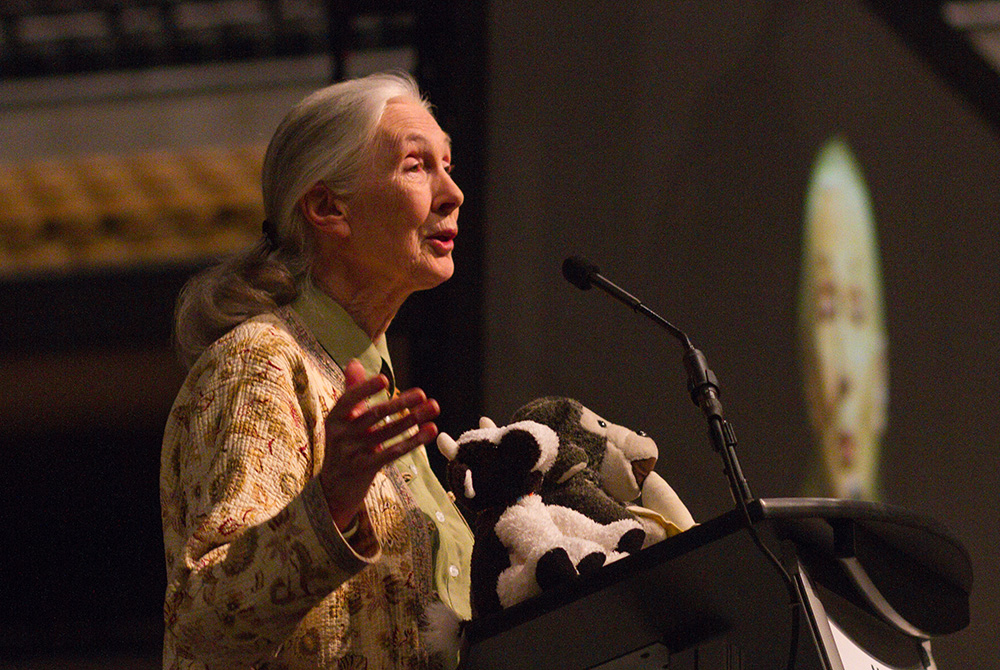
Jane Goodall speaks at Mizzou Arena Sept. 17, 2014, in Columbia, Missouri. (Wikimedia Commons/Mark Schierbecker, CC by SA 4.0)
The theme of this year's Earth Day celebration is "Restore Our Earth," a hope-filled call to action. But with so much evidence to the contrary, the instigative question still lingers: Can we really save our planet?
Can we stop the bleaching of the Great Barrier Reef? Can we purify the smog-filled air of Beijing? Can we prevent our planet's temperatures from rising, save our forests from disappearing, and protect our watersheds from the thirst of a burgeoning world population?
Truthfully, it's hard to remain committed in the face of what is often portrayed as a fait accompli. And then, just when the last environmental straw feels like it's breaking, a whisper emerges from within the cacophony of doom: All is good. Goodall is here.
Jane Goodall, famed primatologist, researcher and conservationist, is best known for her work with the chimpanzees of Tanzania. But these days, having recently turned 87, Goodall has left the jungle for the road, raising both funds and awareness for the most important fight of our collective lives.
I count myself among the fortunate souls who have met Ms. Goodall. We crossed paths a few years ago, when she came to the campus of Phillips Andover as part of a speaker series. She spoke in our chapel, the only space that could accommodate her legion of fans.
Per her insistence, the pews on the floor were reserved for students only, leaving the adults to lumber up to the balcony. She was right to predict a record crowd. Nearly 1,000 starstruck teenagers packed the sanctuary that night, much to her delight.
As Goodall stepped lightly onto the stage, she exuded both an air of serenity and gravitas. Dressed in black, a scarf tied loosely around her shoulders and hair pulled back in a ponytail, there was nothing showy about her. In fact, as those gathered rose to their feet with applause when she first appeared in the spotlight, she seemed slightly bemused, as if she didn't understand what all the fuss was about.
Over the next 90 minutes, Goodall spoke without notes, a sip of water or even a shifting of weight. Feet tucked closely together and knees locked, she didn't move a muscle for the entire duration of her speech.
At first, her utter stillness didn't quite register, but as the minutes clicked by, I was struck by her placid affect. Perhaps it was a remnant of her years spent in the jungle, where for long stretches of time she sat motionless and silent. Or maybe she had developed a certain endurance from her time on the speaking circuit.
It was only when I looked back into the faces of the audience that I realized it was so much more.
Advertisement
In a culture where hundreds of stimuli vie for our attention every minute of every day, Jane Goodall is certainly an anomaly. She didn't rely on technological wizardry to keep our attention. She didn't reduce her remarks to pithy sound bites to keep us engaged. She just stood there, looked us in the eye, and told the truth.
Beneath her soft voice was a steely intensity I have rarely experienced. Mesmerized by her whispers of calamity, I couldn't take my eyes off her. Nor could anyone else.
Two stories remain with me from that night, before she became "Jane Goodall," famed scientist and environmental advocate. The first recounted her reading the popular adventure novel Tarzan of the Apes. Although just a child, Goodall was completely enamored by the story of the boy raised by apes.
Goodall would find her true purpose in the pages of that book, convinced at an early age that life with the apes was her destiny, as well. Her love affair with the jungle began that fateful day, one she teasingly mocked with her now-famous line, "Apparently, Tarzan married the wrong Jane!"
The second involved a silent vigil she held as a young girl, hunkered down in her family's chicken coop. Try as she might, she could never quite discern how hens produced their eggs.
Rather than ask an adult to explain the mysterious process, she decided to just see for herself. Hour after hour she sat quietly while the hens roosted, blithely unaware that her parents might grow alarmed over her prolonged and unexplained absence.
When an egg finally emerged, she promptly plucked it out of the straw and raced home to show her mother. Instead of chastising her daughter for her disappearance, her mother asked Jane questions about her inspired adventure.
Even now, this is what Goodall remembers most about her mother, that she always encouraged her curiosity and her penchant for wandering, even when she broke the rules to do it.
As we near the 51st anniversary of Earth Day, Jane Goodall continues to shape the narrative regarding issues of climate change, conservation and environmental stewardship. If we as a species are to survive and thrive, so must the rest of Mother Earth.








